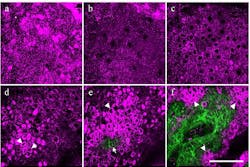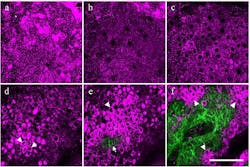Microscopy technique gauges skin’s true age
Recognizing that there is no standardized way to measure the extent of age damage in skin, researchers at National Taiwan University used harmonic generation microscopy (HGM) to peer noninvasively beneath the skin surface to measure natural age-related changes in the sizes of skin cells. The results can be used to study the general phenomenon of skin aging and may help provide an index for measuring the effectiveness of âanti-agingâ skin products.
In a study, Chi-Kuang Sun, a distinguished professor at National Taiwan University and chief director of the universityâs Molecular Imaging Center, along with medical researcher and dermatologist Yi-Hua Liao and colleagues, evaluated 52 subjects ranging in age from 19 to 79 years old. The researchers focused a brief burst of infrared laser light into the skin of the subjectsâ inner forearms, an area that is generally protected from sun damage, which accelerates natural aging. The beam penetrated to a depth of about 300 µm, or approximately where the epidermis and the dermis meet.
With HGM, which has previously been used to study developing embryos, a concentrated beam of photons is sent into a material. The photons naturally oscillate at a particular frequency and as they interact with the material, they generate âharmonicsââvibrations that are multiples of the original frequency, which are characteristic of the material structure and properties. In an imaging system, harmonics can reveal different structures at very high resolution. In their study, the team scanned for reflected second and third harmonic photons, and from those measurements, produced a high-resolution 3D map of the tissue that revealed structures within the skin cells.
Natural aging, the scanning showed, caused a significant increase in the overall size of cells known as basal keratinocytesâthe most common cells in the outermost layer of skinâas well as in the sizes of their nuclei. However, other types of skin cells, known as granular cells, did not show a similar pattern. Thus, says Sun, the relative changes in the two types of cells can serve as an index for scoring natural or âintrinsicâ skin agingâthe aging of skin caused by programmed developmental or genetic factors.
A skin age index would provide a standardized, quantitative scale that could be used rate the true âageâ of skin, from young (less age-related damage) to old (more age-related damage). The scale could give doctors another tool to monitor the overall health of skinâby investigating whether the skin of certain individuals or populations ages faster or slower than average, tracking the aging of an individualâs skin over time, or testing how effective anti-aging treatments are at slowing the rate of skin aging.
Intrinsic, or chronological, aging is different from extrinsic aging, which is caused primarily by sun exposure. âThere are a lot of extrinsic factors that can accelerate the aging process, such as smoking, ultraviolet light, and stress,â says Sun. The researchers found that the extent of extrinsic skin aging in their study subjects varied depending on occupation, personal habits, and skin type, but because the researchers looked at skin on the sun-protected inner forearm, their findings provide a measure of the primarily genetically-based intrinsic skin aging.
âThis could provide an index for someone who cares about the health of their skin and might also provide a test-bed for measuring the effectiveness of âanti-agingâ skin products,â Sun says.
The work appears in Biomedical Optics Express; for more information, please visit http://www.opticsinfobase.org/boe/abstract.cfm?uri=boe-4-1-77.
-----
Follow us on Twitter, 'like' us on Facebook, and join our group on LinkedIn
Laser Focus World has gone mobile: Get all of the mobile-friendly options here.
Subscribe now to BioOptics World magazine; it's free!



